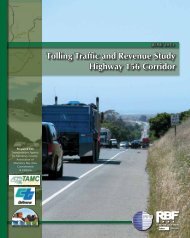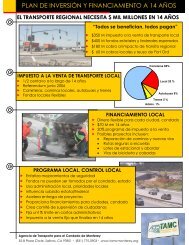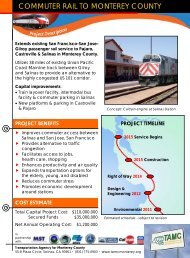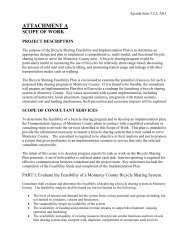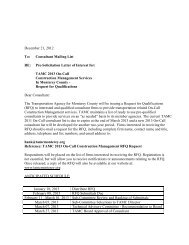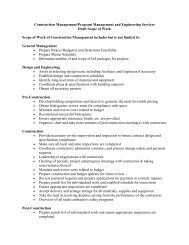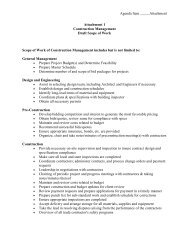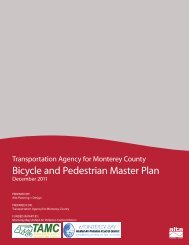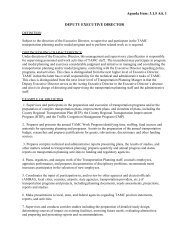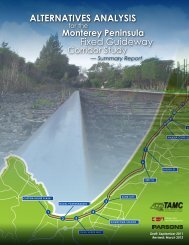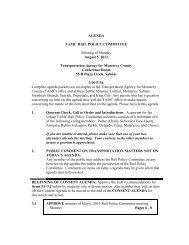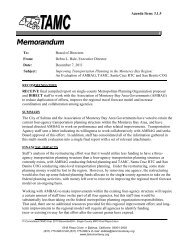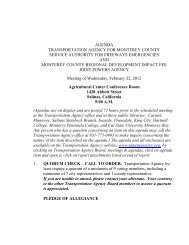Commuter Rail Extension Alternatives Analysis - Transportation ...
Commuter Rail Extension Alternatives Analysis - Transportation ...
Commuter Rail Extension Alternatives Analysis - Transportation ...
You also want an ePaper? Increase the reach of your titles
YUMPU automatically turns print PDFs into web optimized ePapers that Google loves.
CALTRAIN EXTENSION TO MONTEREY COUNTYALTERNATIVES ANALYSISFigures 2-5 and 2-6 illustrate the overall operation of Santa Clara County’s freeway system in 2005.This assessment is based on VTA’s LOS density thresholds, which are worse than HCM 2000 forLOS D, E, and F. Figure 2-7 shows only those freeway segments which operate at LOS F in eitherthe AM or PM peak hour. All of these graphics indicate that most or all of the freeway routes used byMonterey County resident commuters are heavily congested as of 2005 1 .Insofar as future traffic conditions, VTA anticipates that congestion will worsen even with an investmentof some $766 million in highway improvements by Year 2030. VTA’s Valley <strong>Transportation</strong> Plan2030, adopted February 2005, indicates that Santa Clara County population is expected to grow by27 percent and jobs by 37 percent over Year 2000 levels. Over the same time period, vehicle trips willincrease by 39 percent during the morning peak hour and 36 percent during the afternoon peak hour.As freeway capacity will grow by only 5.6 percent, substantial increases in travel time for somecommute trips is expected.As part of its congestion monitoring effort, VTA collects travel time information for representativecommute origin–destination (O–D) pairs. One of these O–D pairs surveys travel times between aresidential area of Morgan Hill, 10 miles north of Gilroy, to a location in Santa Clara near U.S. 101and Montague Expressway (see Figure 2-8).Table 2-5 reports the observed travel times between these pairs for the period from 1997 to 2005,plus the estimated travel time in 2030 based on forecasted traffic growth and freeway performance.Compared with current (2005) conditions, VTA forecasts that travel time will increase by 48 percentduring the AM peak hour(s) and 154 percent during the PM peak hour(s) for single occupant vehicles.REGIONAL RAILPassenger rail service is currently being increased and expanded throughout northern California toaddress longer-distance commuting needs and support the region’s growing economy. Figure 2-9illustrates the existing and proposed regional (non-urban) passenger rail network, which includesAmtrak’s Capitol service to Sacramento, the Altamont <strong>Commuter</strong> Express service to Stockton, andthe Caltrain commuter rail service between San Francisco and Gilroy. The regional highway networkis also illustrated for reference.Caltrain ServiceCaltrain is a commuter rail system that has linked San Francisco Bay Area peninsula communitieswith one another for more than 130 years. Until July 1980, the Southern Pacific <strong>Transportation</strong>Company owned and operated the commuter rail service for profit. <strong>Commuter</strong> rail ridership peakedduring World War II at around 32,000 passengers per day and declined thereafter to a low of 14,000riders in 1977 as Southern Pacific petitioned the California Public Utilities Commission to discontinueservice.After substantial negotiation, the State of California (through Caltrans) entered into a purchase-ofserviceagreement with Southern Pacific in July 1980. The purpose of this agreement was to continueand improve commuter rail service between San Jose and San Francisco. This agreement continueduntil July 1992, at which time the administration and operation of Caltrain was transferred from theState of California to the Peninsula Corridor Joint Powers Board (JPB)—a three-member agencycomprising the City and County of San Francisco, the San Mateo County Transit District, and VTA.By that time, ridership had recovered and stabilized at approximately 21,000 passengers per day.1Complete level of service, density, speed and volume information for all freeway segments are provided in VTA’s 2005 Monitoring andConformance Report, dated April 2006.parsons CHAPTER 2: EXISTING AND FORECAST CONDITIONS 30



